This article has been reviewed according to Science X's editorial process and policies. Editors have highlighted the following attributes while ensuring the content's credibility:
fact-checked
peer-reviewed publication
trusted source
proofread
New method for detecting unusual air turbulence holds promise for aviation safety

With air turbulence presenting a significant safety concern in civil aviation, especially amidst the growing impacts of climate change and the expansion of the aviation industry, the need for effective monitoring and mitigation strategies has become paramount.
Traditionally, the eddy dissipation rate (EDR) has served as the standard metric for assessing turbulence in aviation. However, a new study published in Advances in Atmospheric Sciences proposes a novel approach by employing a symbolic classification approach based on genetic programming, aiming to detect turbulence anomalies directly from quick access recorders (QARs) aboard aircraft.
QARs are airborne flight data recorders designed to capture environmental, equipment, and operational parameters throughout a flight, providing valuable insights into flight conditions.
Hongying Zhang from Civil Aviation University of China, the corresponding author of the study, says, "QAR data are a standard feature in modern aircraft, so our method eliminates the need for direct EDR computation, making it universally applicable and easily implementable across the aviation sector."
In essence, the integration of symbolic classifiers into turbulence monitoring systems holds significant promise for enhancing civil aviation safety amid escalating environmental and operational challenges. "By integrating symbolic classifiers into turbulence monitoring systems, we can streamline the detection process and improve the accuracy of identifying turbulence anomalies," says co-author Pak-Wai Chan from Hong Kong Observatory.
Air turbulence poses a tangible threat to flight safety, necessitating innovative approaches for its detection and mitigation. The findings of this research provide a reliable and efficient method for identifying turbulence anomalies, by leveraging existing data sources and advanced classification techniques. Airlines and aviation authorities can then enhance their capacity to ensure passenger comfort and prevent potential losses associated with turbulence-related incidents.
While the current method focuses on detecting the presence or absence of turbulence anomalies, future research aims to refine the approach by developing multi-classifiers for classifying turbulence levels, according to the research team. Additionally, efforts will be directed toward building regression models to estimate the severity of turbulence, further enhancing the safety and efficiency of air travel.
More information: Zibo Zhuang et al, Detection of Turbulence Anomalies Using a Symbolic Classifier Algorithm in Airborne Quick Access Record (QAR) Data Analysis, Advances in Atmospheric Sciences (2024). DOI: 10.1007/s00376-024-3195-x





















